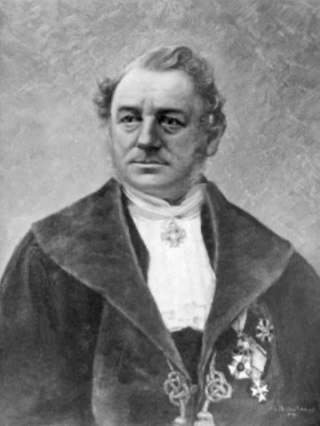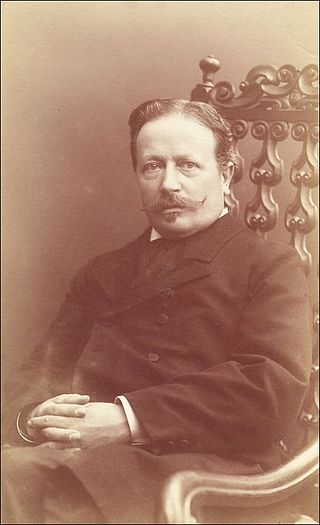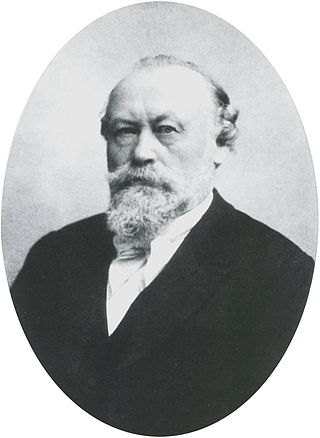
Hubert von Luschka, born Hubert Luschka, was a German anatomist. He lent his name to several structures, including the foramina of Luschka, Luschka's crypts, Luschka's joints, and Ducts of Luschka. His name is also associated with Luschka's law, an anatomical rule concerning location of the ureters.

Paul Emil Flechsig was a German neuroanatomist, psychiatrist and neuropathologist. He is mainly remembered today for his research of myelinogenesis.

Max Johann Sigismund Schultze was a German microscopic anatomist noted for his work on cell theory.

Karl Friedrich Mohr (November 4, 1806 – September 28, 1879) was a German chemist famous for his early statement of the principle of the conservation of energy. Ammonium iron(II) sulfate, (NH4)2Fe(SO4)2.6H2O, is named Mohr's salt after him.

The vestibulospinal tract is a nerve tract in the central nervous system. Specifically, it is a component of the extrapyramidal system and is classified as a component of the medial pathway. Like other descending motor pathways, the vestibulospinal fibers of the tract relay information from nuclei to motor neurons. The vestibular nuclei receive information through the vestibulocochlear nerve about changes in the orientation of the head. The nuclei relay motor commands through the vestibulospinal tract. The function of these motor commands is to alter muscle tone, extend, and change the position of the limbs and head with the goal of supporting posture and maintaining balance of the body and head.

The lateral vestibular nucleus is the continuation upward and lateralward of the principal nucleus, and in it terminate many of the ascending branches of the vestibular nerve.

Gustav Albert Schwalbe, M.D. was a German anatomist and anthropologist from Quedlinburg.

Karl Friedrich Otto Westphal was a German psychiatrist from Berlin. He was the son of Otto Carl Friedrich Westphal (1800–1879) and Karoline Friederike Heine and the father of Alexander Karl Otto Westphal (1863–1941). He was married to Klara, daughter of the banker Alexander Mendelssohn. Westphal died in Kreuzlingen in 1890.

Salomon Stricker was a pathologist and histologist from the Austro-Hungarian Empire.

Georg Theodor Ziehen was a German neurologist and psychiatrist born in Frankfurt am Main. He was the son of noted author, Eduard Ziehen (1819–1884).

Eduard Friedrich Wilhelm Pflüger FRSFor HFRSE was a 19th-century German physiologist.

Julius Bernstein was a German physiologist born in Berlin. His father was Aron Bernstein (1812–1884), a founder of the Reform Judaism Congregation in Berlin 1845; his son was the mathematician Felix Bernstein (1878–1956).

Johann Alexander Ecker was a German anthropologist and anatomist, born in Freiburg im Breisgau. He was the son of Johann Matthias Alexander Ecker (1766–1829), a professor at the University of Freiburg.

Franz Boll was a German physiologist and histologist. He was the son of Lutheran theologian Franz Boll (1805–1875).

Karl Hürthle was a German physiologist and histologist who was a native of Ludwigsburg.

Christoph Theodor Aeby was a Swiss anatomist, anthropologist, and academic. His main scientific interest was comparative anatomy and his studies were said to be facilitated by a large collection of bones, which he assembled in Bern. He is particularly noted for his work on the bronchial tree, which was published as a monograph in 1880. Through his work, a term in anthropology was named after him - the "Aeby's plane", which pertains to the plane through the nasion and brasion.
Ludwig Julius Budge was a German physiologist.

Adolph von La Valette-St. George was a German zoologist and anatomist, known for his research in developmental biology.
Eduard Müller was a German internist and neurologist.

Alexander Stanislavovich Dogiel or Dogel, was a Russian Empire histologist and neuroscientist. He contributed to a morphological classification of nerve cells. The cells of Dogiel, bipolar neurons of the spinal ganglia, are named after him.



















